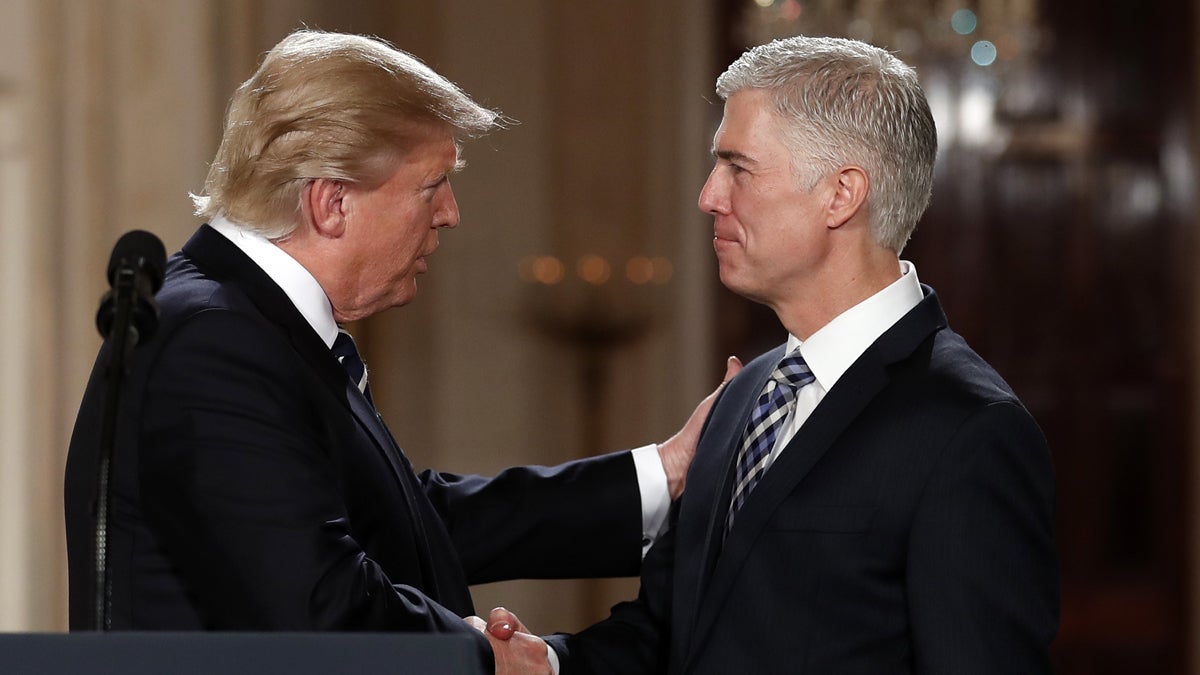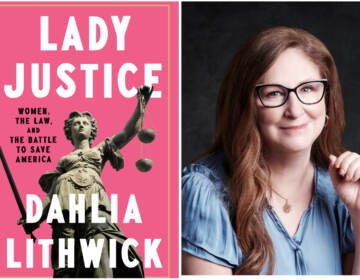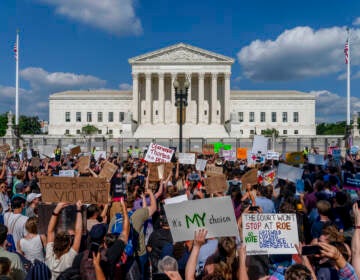Imagining an America without Roe v. Wade
With the ascension of Neil Gorsuch, were the Supreme Court to jettison Roe v. Wade, it’s fair to say the court would be ushering in a dark regime such as prevails in … Europe?

President Donald Trump watches as Supreme Court Justice Anthony Kennedy administers the judicial oath to Judge Neil Gorsuch during a re-enactment in the Rose Garden of the White House White House in Washington, Monday, April 10, 2017. (AP Photo/Evan Vucci)
Let’s speculate, wildly. Let’s say that with the ascension of Neil Gorsuch, the Supreme Court jettisons Roe v. Wade.
Imagine the uproar: “Misogyny,” “devastating to women’s health,” “an extreme right-wing religious agenda.”
Well, it’s fair to say the court would be ushering in a dark age such as prevails in … Europe.
Oh-so-liberal Europe?
Consider Austria and Belgium and the Czech Republic, or Denmark and Finland and France, or Germany and Hungary and Italy, or Spain and Sweden and Switzerland — all these countries ban abortion on demand, albeit with exceptions, some stinting, some elastic, at varying stages ahead of the fetal- viability standard set by Roe, generally said to be 24 weeks. Restrictions in Europe often start at 12 to 14 weeks.
Europe may best illustrate what happens when a broadly liberal society like our own lets legislatures resolve the abortion question, free of judicial rulings. It arrives at a rough consensus that goes along with abortion, no questions asked, but only up to the point where the unborn too closely resemble the already born. Contrary examples notwithstanding — looser regulation in the Netherlands and the United Kingdom (to say nothing of Canada), tighter in Ireland and Poland — the consensus takes its direction from gut feel, not creeds, whether those of the Vatican or Planned Parenthood.
Most Americans, too, are okay with abortion in early pregnancy. Yet many of them grow queasy as the image on the sonogram comes into focus. Five times over the past 20 years, most recently in December 2012, Gallup has found national majorities supporting “generally legal” abortion within the first three months of pregnancy and majorities opposing it later.
It is inevitable, then, that abortion-restriction initiatives should surface in the states, most recently in Pennsylvania. Bills before the Republican-dominated legislature, the prime sponsors being women, would ban abortion after 20 weeks, with an exception “to prevent either the death of the pregnant woman or substantial and irreversible impairment of a major bodily function.” Seventeen other states have already made similar measures law, albeit subject to constitutional challenge. In Pennsylvania, Democratic Gov. Tom Wolf has vowed his veto.
(The Pennsylvania bills and references in this article refer to gestational age, or the time since the woman’s last menstrual period. In most other states, the 20 weeks in “20-week laws” are calculated as of fertilization, or about two weeks following the last period. Full term, by gestational age, is approximately 40 weeks.)
These state laws are intended to serve as a counter-Roe strategy linked to a controversial theory of fetal development which has more support among politicians than scientists. The argument is that by 20 weeks, however calculated, the fetus can feel pain during the violence of abortion technique common to this stage of pregnancy, and so the onset of pain perception, not fetal viability, should decide the judiciary. The American Congress of Obstetricians and Gynecologists says that this contention has got the science wrong, that pain postdates viability.
But if Roe fell, then what?
As regulation passed to the states, abortion would hardly come to a halt. A good number of states would maintain the status quo. Think California and Oregon, New York and Vermont. Some states with newly restrictive laws would preserve abortion in early pregnancy and the usual exceptions for endangerment to the woman, rape and incest, and fetal anomalies. As for severe regulation, make a guess. Texas? Louisiana?
You can favor a less liberal abortion regime than exists in the US today, as I do, and still look for the usual exceptions. The maddening thing in Pennsylvania right now is that you’re still looking.
Here’s just one omission. The Pennsylvania bills provide no exception for the hard case that is anencephaly, in which essential parts of the fetal brain, the skull, and the scalp, don’t develop. Often the diagnosis isn’t made before 20 weeks. The baby dies shortly after birth, if death has not already come in the womb. The legislature would leave women confronting this prenatal disaster — some 15 women in Pennsylvania annually — no choice but to take their sorrowful pregnancies to term (or to fetal demise in utero).
In their heedless rush to legislate, “pro-life” solons in Harrisburg might yet give point to the otherwise mindless “pro-choice” complaint that any further abortion restrictions whatsoever amount to a “war on women.”
About one percent of abortions in this country are done after 21 weeks. That’s a pro-choice talking point. But its flippancy doesn’t survive the observation that one percent makes for roughly 12,000 a year. As for abortions after the first 13 weeks, they approximate 100,000 a year, a rate of about 11 every hour.
However you do the tally, and whether your concern is for the unborn or for women tormented by pregnancies gone terribly wrong, it’s a lot of lives for which state lawmakers would become responsible in a nation absent Roe.
But then we’re only speculating about a court ruling we’ll never see — unless we do.
—
Richard Koenig is a NewsWorks contributor and the author of “No Place To Go,” an Amazon Kindle Single concerning the need for better sanitation in the developing world. He lives in Newtown Square, Pennsylvania.
WHYY is your source for fact-based, in-depth journalism and information. As a nonprofit organization, we rely on financial support from readers like you. Please give today.




